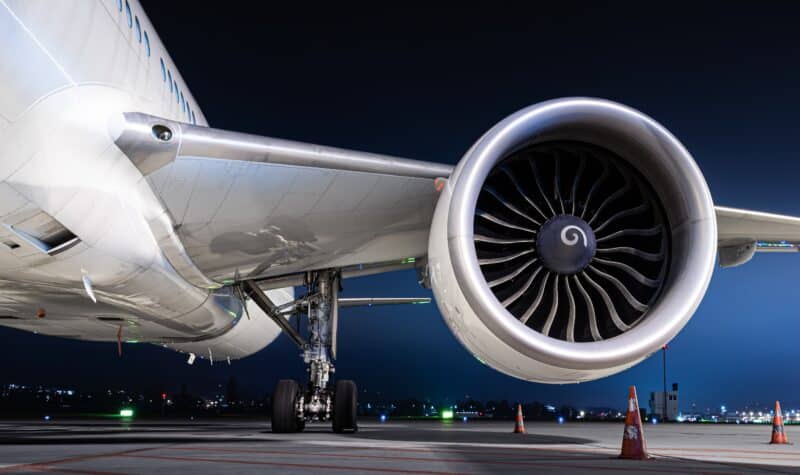SUMMARY
- The UK Government finalised its sustainable aviation fuels (SAF) mandate, which includes a sub-target for power-to-liquid (PtL) fuel, buy-out price and sustainability criteria to be met.
- There are several existing funds that the government has delivered in support of SAF, but the industry still requires further financial support.
- The policy landscape for SAF will likely evolve in the short term, with the potential for new proposals targeting fuels and net zero aviation more broadly with a new Labour government.
The new Labour government in the UK is in the process of designing and delivering its policy framework for achieving net-zero aviation. The UK aerospace industry is the second largest in the world1 and aircraft, engine and parts manufacturing is expected to be the country’s third biggest export in 2024, totalling $24.6 billion2. The government views the sector as a vital part of the UK’s economy, alongside being an influential player in the global market. However, with international and domestic aviation accounting for around 8 per cent of the UK’s greenhouse gas (GHG) emissions3, there is an urgent need to implement policies that will ensure the sector aligns with climate targets.
The Jet Zero Strategy, launched in 2022, outlined the previous government’s strategic vision and plan for reaching net-zero aviation by 2050. A Jet Zero Council was established formed of senior industry representatives and policy-makers, to provide strategic oversight of the government’s plans as key stakeholders in the sector’s transition, which has since been superseded by a Jet Zero Taskforce launched in November 20244. Within these current plans, sustainable aviation fuel – or SAF – is noted as ‘one of the key levers available to government and industry to accelerate the transition to net-zero aviation’5, and they are aiming for 5 plants to be under construction in 2025. The UK’s SAF industry could be worth £16.7 billion per year in exports by 2050, supporting approximately 130,000 highly paid jobs6, and it is our view that the government has a leading role in delivering this huge opportunity by establishing a sustainable, high-integrity SAF market for the UK and beyond.
Since coming to power in July 2024, the government has made progress in sustainable aviation, including introducing a SAF Bill during the King’s first speech to the House of Commons under the new Labour government on July 17, 20247. The Sustainable Aviation Fuel (Revenue Support Mechanism) Bill aims to support SAF production by introducing a revenue certainty mechanism, crucial for alternative fuel projects to secure financing. The new Government has also outlined a number of initiatives regarding SAFs which it sees as ‘an important part of the strategy to decarbonise air travel’, including a commitment to the SAF mandate starting in January 20258, and over £100m of new funding for ‘cutting-edge new green aerospace projects’9.
SAF mandate
The UK SAF mandate was signed into law in November 2024, which once enforced will require jet fuel suppliers to blend SAF into conventional aviation fuel at increasing concentrations, much like the European Union’s ReFuelEU SAF mandate. These blend quantities increase from 2 per cent SAF as a percentage of total jet fuel demand by 2025, to 10 per cent by 2030 and 22 per cent by 2040. They also launched a ‘SAF Clearing House’, to provide technical support and funding towards the development, testing and qualification of SAFs10.
Similarly to ReFuelEU, the policy has included a sub-mandate on ‘power-to-liquid’ (PtL) fuels – referred to as synthetic aviation fuels in the EU mandate – due to their ‘high GHG emissions savings potential and low land use change risk’11. The Government noted that this type of high-integrity SAF will require more support to get to market and help in bringing costs down for their inputs such as green hydrogen and renewable energy, therefore it was expected that the sub-target would be ambitious. However, the PtL target has fallen short of expectations and is lower than the counterpart target within ReFuelEU, requiring only 0.5 per cent PtL by 2030 and reaching a significantly lower target of 3.5 per cent PtL by 2040 as compared to the EU’s 10 per cent target for the same year.
The current mandate includes a cap to hydroprocessed esters and fatty acid (or ‘HEFA’ fuels) which, though cheap and abundant, don’t align with their commitment to only use waste residues for fuels and helps create space in the market for newer SAF technologies to become competitive. The HEFA cap starts at 2 per cent in 2025 and rises to 7.8 per cent by 2040. The mandate also includes a buy-out price whereby jet fuel providers have a cost penalty should they not supply enough SAF. The buy-out mechanism for the main SAF obligation is £4.70 per litre and the PtL obligation is £5.00 per litre. Figure 1 compares the mandate targets within the UK’s SAF mandate to those of ReFuelEU.

Funding
The UK Government allocated significant but insufficient funds to support the growth of the SAF market. The Department for Transport (DfT) estimate the costs for one SAF plant could exceed £1 billion, therefore there is a significant gap in plans sufficient to meet the ambition of ‘having 5 commercial SAF plants under construction in the UK by 2025’12 and ‘no clarity on who will fund them’13. These funding mechanisms target activities across the TRLs, from the innovation stage through to demonstration. This mapping provides a snapshot of funding available as of August 2024:
| Fund name | Organisation(s) | Description | Total fund |
| Currently closed | |||
| Green Fuels, Green Skies | – DfT – Ricardo | Competition to support UK companies that pioneer new technologies to convert household rubbish, waste wood and excess electricity into SAF. | £15 million. |
| SME Programme | – Aerospace Technology Institute (ATI) – DBT – Innovate UK | A funding programme tailored to the needs of SMEs to strengthen and further encourage technology innovation within the supply chain and civil aerospace sector. | Grants totalling up to £10 million a year. |
| Hydrogen Innovation Initiative Demonstration | – Connected Places Catapult – Hydrogen Innovation Initiative (HII) | Connected Places Catapult, acting as a partner of the HII, is looking to procure results from near-term demonstrations. | A budget of up to £50,000 per project to contribute to the costs of the demonstration activities. |
| Jet zero: aviation’s non-CO2 impacts on the climate | – DBT – DfT – Natural Environment Research Council (NERC) | Collaborative research which focuses on the underpinning science of aviation’s non-carbon dioxide (CO2) impacts – including from SAFs – and how they interact with climate over time with the view to identifying benefits, mitigation options, informing industry and government policy decisions. | £10 million. |
| Tomorrow’s Engineering Research Challenges | – EPSRC | Funding opportunity supporting diverse teams from across disciplines to forge new research capabilities. | £7,000,000. |
| Accelerating research outcomes to deliver a prosperous net zero | – Engineering and Physical Sciences Research Council (EPSRC) | Provides follow-on funding to research outputs that are ready to move beyond fundamental research and need additional resources to be taken up as a solution by users. | £7,500,000. |
| Live | |||
| Advanced Fuels Fund | – Department for Transport (DfT) – Ricardo – E4Tech | Grant funding to first-of-a-kind commercial and demonstration-scale projects in the UK at all development stages up to construction starting. | £135 million to March 2025. |
| Strategic Programme | – Aerospace Technology Institute (ATI) – Department for Business and Trade (DBT) – Innovate UK | Targeting innovators, this programme provides funding for research and technology development in the UK to maintain and grow the UK’s competitive position in civil aerospace. | ≈£1.7 billion to 2025, with industry co-funding taking the total to >£2 billion. |
| Future Flight Challenge Fund | – DBT – UK Research and Innovation (UKRI) – Innovate UK | This fund builds the aviation ecosystem needed to speed up the introduction of electric sub-regional aircraft, advanced air mobility vehicles and drones into the UK. | £300 million co-invested by government and industry. |
| UKRI SME innovation loans | – UKRI | Funds businesses to develop innovative products, processes or services that can maximise return on investment to the UK’s economy and society. | Not specified. |
| Emerging Energy Technologies Fund (EETF) | – Scottish Government | Funding to accelerate low carbon infrastructure projects that will be essential to deliver net-zero. | £180 million. |
Possible government interventions
- Revising and raising the ambition of the Jet Zero Strategy: Some civil society organisations14, 15have stated that the Jet Zero Strategy does not go for enough in terms of climate ambition and should be updated or potentially deviated away from entirely. As of yet, it is unclear what the new Labour government plans to do with the existing Strategy.
- Revenue certainty mechanism (RCM): Following the publication of the mandate, the Department for Transport (DfT) under the previous government launched a consultation on the design of a scheme, which will ‘provide an incentive for the production of SAF via price support from tradable certificates with a monetary value’16. The RCM was mentioned under the SAF Bill in the King’s Speech in July, where he stated “This Bill will support SAF production in the UK by providing revenue certainty to encourage investment in the construction of SAF plants across the UK”17. However, the details of the RCM are yet to be finalised. The consultation outlined four options including:
- A Guaranteed Strike Price (GSP): similar to a Contracts for Difference (CfD) model, an agreed price is paid per litre of fuel produced to SAF producers who choose to apply to the scheme. If a SAF producer sells SAF at a market price lower than the ‘strike price,’ they receive the difference. Conversely, if the market price exceeds the ‘strike price,’ they return the difference.
- Buyer of Last Resort (BOLR): a counterparty steps in to purchase SAF certificates when the market price falls below an agreed level. This would thereby agree a minimum price for the producer’s SAF certificates redeemed through the SAF Mandate.
- Mandate Auto-Ratchet (MAR): the mandate would adjust when there is an oversupply in the market, to bring the price of SAF back closer to the buy-out price.
- Mandate Floor Price (MFP): includes a minimum price for certificates which is universally applied through the mandate itself (in addition to the buy-out price).
In June 2024, Climate Catalyst joined 20 other civil society organisations in a letter to urge the government to stay the course in their intention of making the aviation industry pay and avoid public money funding the aviation fuel transition.
- Changes to the UK Emissions Trading Scheme (ETS):
- Emission reduction assumptions for using SAF under the UK ETS may shift to consider a lifecycle analysis of the type of fuel used; currently, using any SAF assumes a 100 per cent emission reduction18. In this instance, PtL fuels would perform more favourably than biofuels.
- A consultation19 was held in May 2024 to evaluate necessary changes to the enforcement and sanctions policy of the UK ETS in light of the establishment of the Carbon Offsetting and Reduction Scheme for Aviation (CORSIA). The outcome of the consultation remains pending.
- The non-CO2 impacts of SAFs may also be introduced, which vary vastly between different fuels but with research ongoing20.
- Long-haul flights which account for most of the UK’s aviation carbon emissions aren’t yet included in the ETS, only domestic and those departing to the European Economic Area21.
- Kerosene tax: At present, aviation is the only transport sector that doesn’t have to pay a duty on its fuel. Implementing a kerosene tax would help to level the playing field between the cost of conventional jet fuel and SAFs, and particularly PtL fuels. Many advocates for this policy also see it as necessary from an equity and just transition perspective, arguing that airlines should not be spared fuel tax when truckers and motorists are not. By some estimates, the revenues generated could be around £6.7 billion per year22, with a precedent set via increases to Air Passenger Duty (APD) in the 2024 Autumn Budget Statement23.
- Safety regulations via Civil Aviation Authority (CAA): SAF can currently be used in jet engines to a maximum blend of 50 per cent with traditional kerosene without the need for any modifications. In late 2023, the CAA granted a permit to Virgin Atlantic to fly on 100 per cent SAF between the UK and US24, which took place without incident. Safety is paramount within the aviation industry and therefore shouldn’t be compromised, yet there are still regulatory barriers that need to be overcome for SAF to be used in higher percentage blends and eventually at 100 per cent. In July 2024, the CAA announced ‘a new working group to continue to support the development of hydrogen as the next step for green fuel in the aviation industry’25.
- Carbon pricing measures: The UK government has planned to implement a new import carbon pricing mechanism from January 202726, similar to the EU’s ‘CBAM’, on carbon-intensive products including steel and hydrogen, which will have an impact on aviation value chains, and apply to scope 1 and 3 emissions.
- Jobs and skills: the UK Government is looking to the aviation industry to create high quality jobs and invest in apprenticeships in the sector, with the recent launch of the Reach for the Sky programme to encourage young people from under-represented groups to pursue a career in aviation.
The new UK Government will likely build upon their predecessor’s policy framework to support the growth of the SAF market as part of an evolving global industry. Activities from the public sector alone will not be enough to see this market take off, and we are working closely with the investor community to accelerate action. To find out more, visit our website or get in touch.
Download this policy mapping for your records.
We aim to update this webpage regularly over time. If you’re interested in keeping a copy of this policy mapping in its current form, download the document below.



